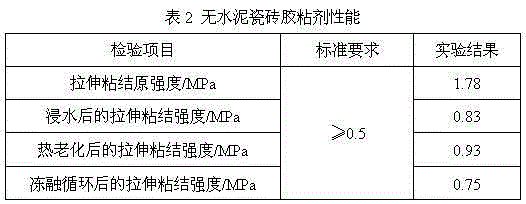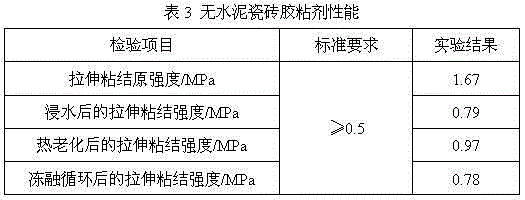Non-cement ceramic tile adhesive
A ceramic tile adhesive, cement-free technology, applied in the field of building materials, can solve the problems of difficult to achieve tile adhesive performance, non-renewable resource consumption, environmental pollution, etc., and achieves the effects of low maintenance conditions, environmental protection, and simple use.
- Summary
- Abstract
- Description
- Claims
- Application Information
AI Technical Summary
Problems solved by technology
Method used
Image
Examples
Embodiment 1
[0023] A cement-free tile adhesive consisting of a cement-free mortar masterbatch and additives;
[0024] The cement-free mortar masterbatch is composed of the following components by mass percentage: 31% ultrafine fly ash, 57.2% river sand, 9.3% lime and 2.5% gypsum; the particle size of the ultrafine fly ash is 5- 10μm;
[0025] The additives include 2.50% of redispersible latex powder, 0.35% of cellulose ether, 0.15% of water reducer, 0.10% of water repellent, and 0.40% of early strength agent; Quality is the benchmark measure.
[0026] The cement-free tile adhesive prepared in the present embodiment is detected, and its detection data are as shown in Table 1:
[0027]
[0028] Its various properties meet the technical requirements of the standard "Ceramic Wall and Floor Tile Adhesive" (JC / T547-2005).
Embodiment 2
[0030] A cement-free tile adhesive consisting of a cement-free mortar masterbatch and additives;
[0031] The cement-free mortar masterbatch is composed of the following components by mass percentage: 28% ultra-fine fly ash, 67% river sand, 4% lime and 1% gypsum; the particle size of the ultra-fine fly ash is 5- 10μm;
[0032] The additives include 4.00% of redispersible latex powder, 0.40% of cellulose ether, 0.30% of water reducer, 0.05% of water repellent, and 0.30% of early strength agent; Quality is the benchmark measure.
[0033] The cement-free tile adhesive prepared in the present embodiment is detected, and its detection data are as shown in Table 2:
[0034]
[0035] Its various properties meet the technical requirements of the standard "Ceramic Wall and Floor Tile Adhesive" (JC / T547-2005).
Embodiment 3
[0037] A cement-free tile adhesive consisting of a cement-free mortar masterbatch and additives;
[0038] The cement-free mortar masterbatch is composed of the following components by mass percentage: 30.5% ultra-fine fly ash, 60% machine-made sand, 7.5% lime and 2% gypsum; the particle size of the ultra-fine fly ash is 5- 10μm;
[0039] The additives include 4.50% of redispersible latex powder, 0.40% of cellulose ether, 0.10% of water reducer, 0.20% of water repellent, and 0.40% of early strength agent; Quality is the benchmark measure.
[0040] The cement-free tile adhesive prepared in the present embodiment is detected, and its detection data are as shown in Table 3:
[0041]
[0042] Its various properties meet the technical requirements of the standard "Ceramic Wall and Floor Tile Adhesive" (JC / T547-2005).
PUM
| Property | Measurement | Unit |
|---|---|---|
| Particle size | aaaaa | aaaaa |
Abstract
Description
Claims
Application Information
 Login to View More
Login to View More - R&D
- Intellectual Property
- Life Sciences
- Materials
- Tech Scout
- Unparalleled Data Quality
- Higher Quality Content
- 60% Fewer Hallucinations
Browse by: Latest US Patents, China's latest patents, Technical Efficacy Thesaurus, Application Domain, Technology Topic, Popular Technical Reports.
© 2025 PatSnap. All rights reserved.Legal|Privacy policy|Modern Slavery Act Transparency Statement|Sitemap|About US| Contact US: help@patsnap.com



